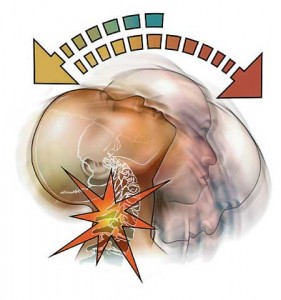Whiplash Neck Injury
 Whiplash is a common term used by those who have been injured in a car accident. It is not a diagnostic term, but a word that is used to describe the method of injury. Commonly when struck from behind, the head is forcibly whipped backwards then forwards. Besides auto accidents, sports injuries and falls commonly cause whiplash neck injury.
Whiplash is a common term used by those who have been injured in a car accident. It is not a diagnostic term, but a word that is used to describe the method of injury. Commonly when struck from behind, the head is forcibly whipped backwards then forwards. Besides auto accidents, sports injuries and falls commonly cause whiplash neck injury.
What structures are injured in a whiplash?
A Whiplash neck injury most commonly cause damage to the “soft tissue structure” of the spine. This includes: muscles, ligaments, fascia, capsules and nerves. Typically what happens, the whip-like motion causes a high-forced stretching of this soft tissue causing microscopic tears within the tissue itself. The body’s first response is typically a form of shock – from the excitement of the event; there is an adrenaline rush. This is why many patients do not feel much pain for the first few hours.
Within a few hours, the damaged tissue begins to swell and become inflamed: this is typically when the pain and stiffness begin. For many patients, it is the next day when they attempt to get up and the pain is excruciating.
Further, the damaged ligaments and muscles prevent the vertebrae (spinal bones) from moving correctly. This altered motion then creates its further irritation and inflammation of the joints and surrounding tissue. This is why the symptoms may be minimal the first few days or weeks, then all of sudden they appear, seemingly “out of the blue!”
In some cases, there may also be damage to the disc (cushions between the vertebrae), causing a bulging or even herniation. This can result in sever nerve pain, or numbness and tingling down an arm. In vary rare instances, there may be fractures of one of the vertebrae.
Common signs and symptoms of whiplash neck injury?
Symptoms of whiplash neck injury vary depending upon what structures have been damaged. In general, neck pain and stiffness are the most common. Other symptoms include:
• Headaches
• shoulder pain
• dizziness,
• jaw pain
• arm pain/weakness
• visual disturbances
• ringing in the ears
• back pain
• sleep disorders
• trouble concentrating
How is whiplash neck injury treated?
The damaged soft tissue structure progresses through a three stage healing process: each with different treatment protocol and objectives.
Stage 1 – Acute Inflammatory Phase
The micro-tears in the damaged soft tissue bleeds and leaks irritating fluid causing edema and inflammation. This typically happens for the first 3 days after injury. The goal of treatment in this phase is to reduce the swelling and inflammation as well as providing pain relief.
Treatment that works best in this phase include: ice, interferential therapy (form of electrical stim), rest, gentle chiropractic mobilization, light massage and soft tissue work. In rare and severe instances, pain medication and anti-inflammatory may be used. However, they should be used with caution since they can actually hinder the bodies healing process.
Stage 2 – Regeneration Phase
The second stage is the Regeneration Phase and typically last about 6-8 weeks. During this stage the body begins to repair the torn soft tissue. Unfortunately, the new tissue is at best 70% normal tissue; the rest is a form of fibrous scar tissue. This stage of care is probably the most important: what happens here sets the stage for the amount of potential limitations or disability the patient may suffer.
The body as an attempt to bridge the torn areas of soft tissue deposits the fibrous scar tissue. Unfortunately, this tissue is smaller and weaker than normal tissue and does not lay down with the grain of the original tissue, but tends to deposit in clumps, matting the damaged fibers together.
Further potential problems can result due to the nature of this tissue. Compared to the normal soft tissue, this fibrous scar tissue is stiffer, has less blood supply and more nerve supply. Thus it can create weaker, but stiffer sensitive scars. Motion, poor posture, repetitive work movement and sudden rapid movement such as certain sports activities can easily aggravate this type of tissue.
The goals of treatment in this phase are to assist normal tissue healing and maintain joint mobility and flexibility.
Phase 3 – Remodeling
The remodeling stage of healing involves the fibrous scar tissue attempting to align itself with the grain of the original tissue. The goal of this phase is to produce the most flexible scar possible.
The best form of treatment in this stage is adjustments and specific exercises. The repetitive stress in the soft tissue from the exercise causes the scar tissue to align with the fibers of the muscles and ligaments.
Proper treatment of whiplash type injuries requires managing care through the three stages of healing. This is the best possible way to achieve pain relief and stabilization of the injured area: thus preventing future pain and disability.
Quality chiropractic care is one of the best treatments for a whiplash neck injury. Chiropractic physicians who have been trained in these types of injuries understand the stages of healing and the appropriate treatments. If you or someone you know has been in an auto accident and you live in Hazelwood, Florissant, Spanish Lakes, Ferguson, Berkeley or North St Louis County, call (314) 731-4383 Ask for Dr. Martin today!
